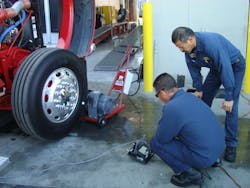Truck tires are a significant investment for fleets, so anything that can help extend tire life may be worth consideration.
“Every time fleets balance truck tires, it’s beneficial because it extends their tire life by a significant amount,” says Bob Jessee, regional sales manager for the wheel balancing technology company Centramatic. “The questions everyone should be asking are: ‘How much will balancing extend tire life?,’ ‘Is it worth the cost [including the time the truck will be out of service to balance all of its tires]?’ and ‘What is the return on investment (ROI)?’”
Balancing truck tires can help increase tire life, decrease driver fatigue and create an overall safer vehicle. For example, Jessee explains, “a smoother ride means less vibration for the mirrors, which provides a better platform for the driver to view traffic.”
A balanced tire also provides less rolling resistance than an unbalanced tire, which can translate to better fuel economy and more miles per gallon.
“As a proactive measure, commercial tire balancing can help reduce tire wear, increase tire mileage and minimize the occurrence of vibrations felt in the steering wheel, seat or cab,” says Mahesh Kavaturu, marketing manager for Goodyear commercial long-haul products.
But, at 10 to 15 minutes per wheel on the truck, wheel balancing can be a time-consuming process. The key is to find the balance between maximizing the tire investment and maximizing vehicle uptime.
Tire balancing intervals
When it comes to how frequently to balance truck tires, there are two conflicting schools of thought: wait until there is a driver complaint, or balance at regular intervals.
"In today's commercial truck tire market, most tires are made to high uniformity standards, so in most cases, you will not need to balance at regular intervals," says David Pressley, product performance director for Michelin. "If you've got to dismount, balance and mount 18 tires per truck [and trailer], that's a huge commitment in time, and some fleets opt not to do it until there's a driver complaint."
Pressley explains that in Michelin's experience, there needs to be a relatively high imbalance for most drivers to notice ride issues, and fleets that balance at regularly set mileage intervals may only correct a large imbalance a small percentage of the time.
That's not to say Pressley advocates not balancing truck tires, because he clarifies that wheel balancing is a positive that can help prevent premature suspension and chassis wear on the truck and trailer, reduce driver fatigue and prevent irregular tire wear.
"Most commercial truck tires are relatively expensive - it's a huge investment in capital, and you should protect that,” he says. “And wheel balancing can increase the overall removal mileage that you get from the truck tire.”
But, he adds, fleets may not see the same ROI if they balance too frequently, because the imbalance they are correcting is so small it doesn't affect driver comfort or offset the vehicle downtime.
At the other end of the spectrum, Hennessy Industries, a manufacturer of tire charger and wheel balancing machines, recommends balancing truck tires at regular intervals.
"A fleet should consider balancing truck tires just as often as a passenger car's tires, or if a vibration is felt," the company suggests. This will help ensure a smooth ride, improved control of the truck and maximum tire life.
Kevin Jones, Rotary Wheel Service product manager, recommends tires be balanced when the driver notices a vibration or change in the feel, an unusual tire wear is present or whenever the truck has its alignment checked. Jones also adds that fleets should also consider balancing after moving a tire to a different location or rotating.
"Usually that means the wheels should be balanced when new and at approximately half the tires' life span," Jones says.
Another consideration when deciding how frequently to balance truck tires is whether the fleet should balance all tires, or only those on steer axles. Many fleets prioritize balancing steer axle tires, since they have a direct impact on driver comfort.
"Most fleets do not balance drive tires," Jones confirms. "We suggest that all tires be balanced. You are saving your company money by balancing every tire/wheel you run."
Types of balancing
When an assembly is out of balance it means there is an unequal distribution of weight on the axis of rotation. This imbalance can be addressed in two ways:
- Static balancing: A static balance treats the assembly as a single plane. Imagine a balance scale where one side weighs more than the other. A static balance adds weight to the lighter side, making the assembly level on both sides. This addresses the “hop” drivers experience when one side of the assembly is heavier than the other. When placing weight for static balancing, Michelin’s Pressley notes that it is important to split the weight required to balance in half and place it on opposing sides of the flanges. This ensures that weight is equally distributed around the perimeter of the tire/wheel assembly.
- Dynamic balancing: Dynamic balancing considers the assembly balance in two planes at the rim flange edges. It will not only determine how much weight should be placed on each side (as with static balancing), but where those weights should be placed to ensure that no part of the tire becomes too heavy. This eliminates the tendency for the rotating assembly to wobble (move from side to side). If the assembly is in dynamic balance, it will also be in static balance. But, a static balance will not necessarily correct a dynamic imbalance.
On-vehicle versus off-vehicle balancing
When balancing tires, fleets have two basic options: balancing tires off the vehicle (as with passenger cars), or balancing tires on the vehicle.
Chris Schutt, technical training specialist at heavy duty wheel alignment and balancing manufacturer Bee Line Company, recommends balancing tires on the vehicle.
“On-the-vehicle balancing takes everything in the rotating assembly into consideration,” he says. “When removing the tire from the vehicle, more labor time is needed to complete the process and only the tire/rim combination is balanced.”
Schutt adds that on-the-vehicle wheel balancing can help the technician find and eliminate radial and lateral tire runout. Radial runout is a changing radius of the rotating assembly that raises and lowers the vehicle, creating a “hop” similar to a static imbalance. Lateral runout is side-to-side movement of the rotating assembly that creates the perception of a wobble like the one caused by dynamic imbalance.
“Another great benefit is that the technician will often feel or even ‘hear’ any excessively loose or rough wheel bearings,” he says. “Loose or rough wheel bearings are also contributors to irregular tire wear patterns.”
Additionally, on-vehicle balancing may aid in overall upkeep of a vehicle.
“On-vehicle balancing can be used to diagnose and/or troubleshoot ride issues,” adds Goodyear’s Kavaturu. “In addition, on-vehicle balancing – with some limitations – can help correct imbalances caused by non-uniformities in other components, such as rotors or brake drums.”
Although balancing tires on vehicle allows technicians to check the wheel, tire and drum and rotor, Rotary Wheel Service’s Jones recommends off-the-vehicle wheel balancing.
“On-vehicle balancing can only correct a static imbalance condition,” Jones explains. “An off-vehicle balance can correct both the static and dynamic imbalance of the wheel/tire assembly.”
Hennessy Industries adds that when balancing a tire on the vehicle, any malfunction with the spindle, hub, shocks or suspension will throw off the balance of the tire.
“When the wheel is balanced off of the vehicle, a true balance of the wheel is attained,” the company says.
In short: on-vehicle wheel balancing can address static imbalance issues, offer faster balancing times and help troubleshoot other vehicle issues that can cause vibration and irregular tire wear; off-vehicle wheel balancing can aid in completing both a static and a dynamic balance of the tire/wheel assembly.
Monitor vibration and tread wear
The major symptoms of wheel balance issues are a vibration in the truck and an irregular wear pattern on the tires.
If there is an indication of a balance issue, the first thing a fleet should do is check the tire pressure, Michelin’s Pressley says.
“Improper inflation of the tire can lead to irregular wear that can cause radial runout, which can cause a vibration from the irregular wear,” Pressley says.
Fleets should also check the wheel assembly to be sure everything is mounted properly; if components were not assembled properly, it could cause a ride vibration.
“It may not be an imbalance issue of the tire, it might be just improper mounting,” Pressley notes.
If these steps do not correct the vibration, fleets should balance the steer tires first, then determine if the vibration issue is corrected. Generally, the front tire assemblies are responsible for vehicle vibrations felt at the steering wheel and/or floor pan under the driver’s feet. If the driver reports a seat vibration, or if cab pitching is evident, the drive tires should also be balanced.
“The best way a fleet can decrease tire wear is to develop a maintenance schedule,” Rotary Wheel Service’s Jones says. “Suspension parts (including tie rods, kingpins and wheel bearings), tire balance and alignment should be checked on a regular basis. This helps catch any wear issues before the tires are ruined.”
Centramatic’s Jessee adds there is an industry misconception that a truck will never ride as smooth as a passenger car.
“Back when all trucks were running ‘Dayton’ spoke style hubs, rims mounted with clamps wobbling down the road with bias ply tires, no one balanced their truck tires,” he explains. “It was a waste of money because there were too many other issues wearing out their tires with that style of wheel assembly.”
The phrase “rides like a truck” stems from that mentality.
Today’s rim style, Jessee says, allows fleets to have a precise mount and balance similar to passenger vehicle wheels. When the truck wheels are properly balanced, tire pressure is correct and alignment and suspension are good, a truck should ride as smooth as a car.
“Many fleets are stuck in the old paradigm of accepting premature wear as normal when the reality is, now it is not normal,” Jessee says. “They never consider balancing because they never have. But there is a lot of money to be saved here. Fleet managers should understand that neutralizing imbalance is vital to extending tire life, and consequently cutting their tire budget by a significant amount.”
Conclusion
Although balancing tires can be a time-consuming commitment, ensuring that the tires remain in balance will help fleets get maximum mileage out of their tires. The key is to monitor vibration and tread wear during preventative maintenance, and address these issues before they shorten the life of the tire. Finding the balance between vehicle uptime and maximum tire life will allow fleets to have the highest ROI for this maintenance measure.
Tips for selecting a wheel balancer
There are many options available when selecting a wheel balancer. Here are some things to consider when selecting the best balancer for your fleet:
- Ease of use
- Portability
- Size/ shop footprint
- Customer support
- Size and type of wheels being balanced
- Calibration process - can the shop check and correct balancer calibration?
About the Author
Stefanie Von Rueden
Assistant Editor - Vehicle Repair Group
Stefanie Von Rueden is assistant editor for the Vehicle Repair Group.
Von Rueden’s background includes professional writing and publishing. Previously, she worked in the Continuing Education department at UW-Whitewater. She has covered the vehicle maintenance and automotive aftermarket since 2016.

